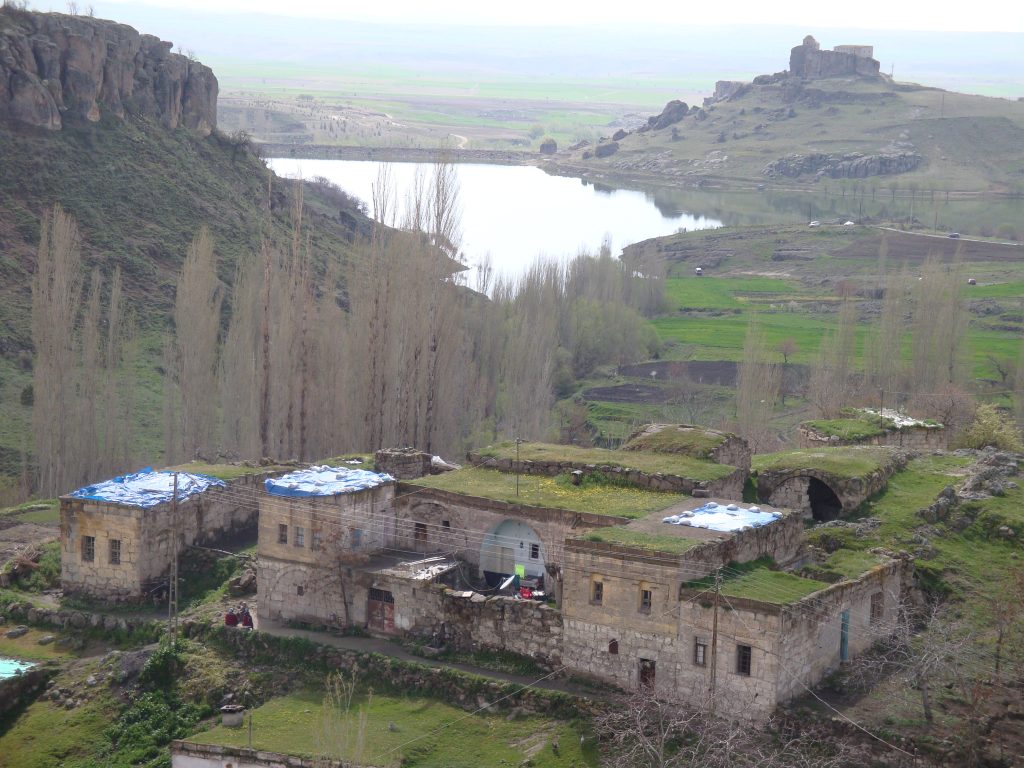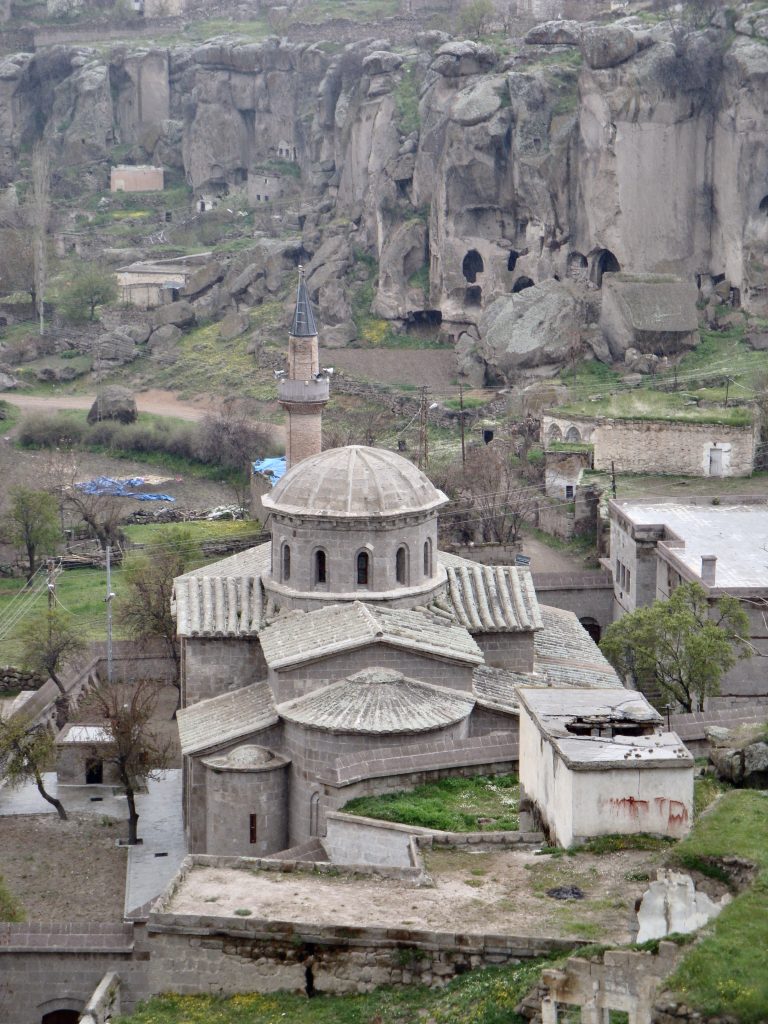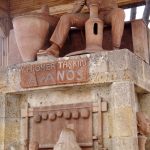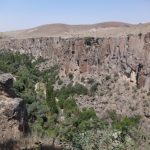Heart of Western Cappadocia Population: 2,700
Old name: Gelveri
Festival: July
Favourite son: St Gregory of Nazianus (Cappadocian Father)
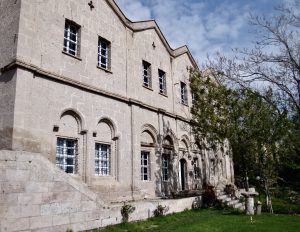 South-east of Aksaray the peaceful small town of Güzelyurt stands in the shadow of Hasan Dağı (Mt Hasan, 3,258m) on the edge of a gorge full of dramatic rock formations. For those who relish authenticity, this is one of the parts of Cappadocia where traditional life lives on in its most unaltered form.
South-east of Aksaray the peaceful small town of Güzelyurt stands in the shadow of Hasan Dağı (Mt Hasan, 3,258m) on the edge of a gorge full of dramatic rock formations. For those who relish authenticity, this is one of the parts of Cappadocia where traditional life lives on in its most unaltered form.
Visitors sometimes base themselves here while they explore the spectacular Ihlara Gorge, then move speedily on. That’s a pity since there’s much more to a place that was, until 1924 and the Greco-Turkish population exchange, the predominantly Greek settlement of Gelveri. With the peaceful air of somewhere overlooked by the outside world, it could hardly be further from the crowds that increasingly besiege the better-known towns of Cappadocia.
Backstory
Güzelyurt (“Beautiful Home”) is most famous as the home of St Gregory of Nazianus (St Gregory the Theologian, c.329-389), one of the Cappadocian Fathers whose writings and teachings helped establish some of the fundamental tenets of Christianity.
A close friend of St Basil of Caesarea (modern Kayseri), Gregory spent much of his life battling what were then seen as heresies but now look like so much theological nit-picking. He was briefly bishop of Constantinople (İstanbul) and it’s there, in the Greek Patriarchate in Fener, that some of his remains have eventually come to rest after Crusading shenanigans that saw them carried off to Rome in 1204.
In 1924 the Greeks of Gelveri moved to Nea Karvali outside the Thracian town of Kavala. Every July some of their descendants return to Güzelyurt to remember their ancestry in a whirlwind of festivities alongside the descendants of Turks from Kozan and Kastoria in Thrace who arrived to take their place.
Around town
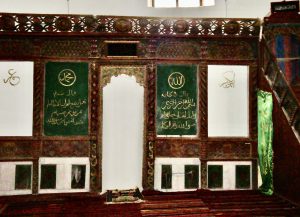 Güzelyurt’s most significant monument is what was once the Church of St Gregory and is now the Büyük Kilise Cami (Big Church Mosque) right in the heart of the old village.
Güzelyurt’s most significant monument is what was once the Church of St Gregory and is now the Büyük Kilise Cami (Big Church Mosque) right in the heart of the old village.
A 19th-century rebuild and a 21st-century restoration make it hard to appreciate that what now looks like a relatively new building actually stands on the site of an original that dated back to the fourth century and which was erected right beside an ayazma (sacred spring), still accessible down a steep flight of steps.
The church is thought to have been commissioned by the Byzantine Emperor Theodosius, and there are those who see in its small dome the model for the great Hagia Sophia (Ayasofya) in İstanbul. Restoration saw a 19th-century wooden iconostasis donated by Tsar Nicholas I moved from the apse to provide a frame for the mihrab, but the pulpit still remains in place, high up on one of the columns.
In the grounds a brick minaret built above the gateway has taken the place of the 19th-century clocktower.
Today the mosque’s congregation is slowly fading away as people move into houses in the upper, newer part of town around the modern Ulu Cami. But Gelveri was one of those Cappadocian settlements that received a significant boost at the end of the 19th century as locals who realised that they would never grow rich if they stayed put took themselves to İstanbul where they were soon making enough money to send some back to pay for schools and churches in their home towns.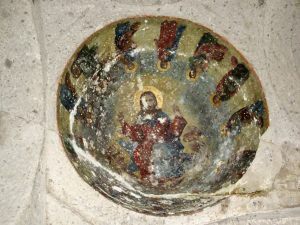
Across the road and up a steep flight of steps is the Sivişli Kilise (Church of the Panagia), which looks like a traditional Cappadocian rock-cut church complete with frescoed dome and apse. It may come as a surprise, then, to discover that it dates back only to this renaissance period at the end of the 19th century.
Not far from the Büyük Kilise Cami you’ll find the entrance to one of Güzelyurt’s two underground cities, pieces in a complex network of hiding places that can be found all over Cappadocia and are believed to date back in part to Hittite times. This one shows clear signs of later reuse with tandır ovens cut into the ground for cooking, but its most famous feature is its squat toilet, isolated along a narrow corridor and the only such convenience so far identified in the underground cities.
It’s well worth taking time to wander around Gızelyurt’s pretty back streets where you’ll find many fine carved gateways, some still bearing inscriptions in Greek. Here, too, you’ll come across several impressive neighbourhood fountains (çeşmes) where people would come to collect water in the days before everyone had a plumbed-in supply.
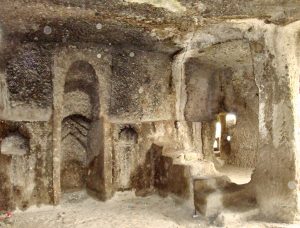 More unexpectedly, you’ll also come across a small rock-cut mosque complete with mihrab and mimber that may have started life as a church. It’s the only mosque completely cut out of the rock in Cappadocia.
More unexpectedly, you’ll also come across a small rock-cut mosque complete with mihrab and mimber that may have started life as a church. It’s the only mosque completely cut out of the rock in Cappadocia.
The main square in upper Güzelyurt is dominated by a stone-gabled monastery built to house a community of Greek monks and their school in 1856; an extra wing was added in 1913, a mere 10 years before the community was forced to leave in the Graeco-Turkish population exchange. It was for many years a hotel.
Around Güzelyurt
On one side of Güzelyurt a somewhat top-heavy stone structure perches on top of a rock overlooking the man-made Gelveri Gölü (Lake Gelveri).
This turns out to be a monastic complex made up of the 19th-century Yüksek Kilise (High Church), otherwise known as the Analipsis Kilise (Ascension Church), and a block containing monastic cells and a small refectory with superb views out towards Hasan Dağı. Cut into the rockface a flight of steps beside a huge cistern provided easy access.
A Neolithic settlement has been identified in fields around the bottom of the rock; slithers of obsidian still littering the ground testify to past tool-making endeavours.
Also within walking distance of the town centre is the lovely Manastir Vadisi (Monastery Valley), with several more rock-cut churches.
Sleeping
Halil’s Pension. Tel: 0382-451 2707
Antique Gelveri Rooms: Tel: 0382-451 2166
Transport info
Fairly regular weekday buses from Aksaray dwindle to just a couple of services at weekends. Without your own wheels it may be easier to visit Güzelyurt on a tour from Avanos. Kirkit Travel has the details (www.kirkit.com).
Day trip destinations
